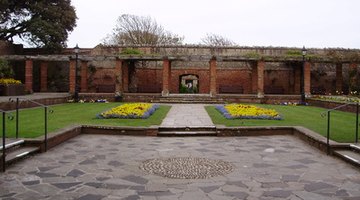Problems With Bluestone Flooring
Bluestone is a type of dense, fairly smooth sandstone quarried in the northeastern United States and used extensively for patio, garden and driveway paving, house trim and window sills, fireplaces, interior flooring and counters.

It is a durable stone that can easily be custom cut and comes in a variety of colors, from grays, pinks, greens and blues to a pale lilac hue. Bluestone has some qualities to be aware of before selecting it for your floors.
Bluestone and Water
Bluestone tiles and pavers are porous, and the stone can soak up water and hold it. This leads to a number of problems. A slight curling in the stone could unseat stones from level alignment on a patio. Another is a splotchy loss of color in the stone. If the bluestone is used in a bathroom, soap residue should be wiped off after each use to prevent build-up. For most situations where exposure to water is frequent or prolonged, the bluestone should be sealed. In high-use areas where the sealer will wear more quickly, it’s important to check regularly to see if the floor needs resealing to protect it from water damage.
Spills and Breakage
Bluestone floors in the kitchen are attractive but have two main disadvantages. First, the stone is unforgiving. If you drop something breakable, it will probably shatter or crack. Standing on the stone for long periods can be hard on the legs and back, so it would be prudent to cover the floor where cooks or dishwashers will work with carpets or padded mats. Spills have to be wiped up and soaked up right away. Bluestone will stain, and oily spills like salad dressing in a kitchen or on a patio will discolor the stone. Sealer will help this but not completely protect the porous stone. Indoors you can use a hydrogen peroxide-based solution for removing stains. Outdoors the natural bleaching and weathering will fade dark stains eventually, but a quick mop-up will minimize the damage.
Efflorescence, Scratches and Chips
One type of discoloration seen on bluestone floors is called efflorescence. Efflorescence appears when the stone absorbs water that then releases mineral salts which rise to the surface and dry like white powder. Sometimes newly installed stone will show this until it “seasons” and the efflorescence can be vacuumed, mopped or swept away. But if the powdery substance continues to show up, you may need to consult a professional to discover what is causing the moisture buildup and the problem. Bluestone is very dense and hard, but it is a sandstone. It can be gouged, scratched or chipped. Mild damage can be gently sanded. Deeper scrapes or nicks might need some professional refinishing to avoid uneven areas and surface breaks where dirt and liquids could stain the stone.
Shipping and Other Costs
Bluestone is quarried in the eastern United States, in parts of Pennsylvania, upstate New York and elsewhere in the region. It can be ordered for delivery anywhere, but shipping can add as much as 25 percent to the cost of the stone. The slightly rough natural finish of most bluestone appeals to many people, but if you want the highly polished, perfectly smooth look of the highest quality tiles, you will pay a premium for it. As bluestone is not naturally shiny, you could save money by deciding to live with the rougher finish and sealing the floor with high-gloss sealer, both to protect the stone and to give it a smooth and shiny appearance.
The Drip Cap
- Bluestone is a type of dense, fairly smooth sandstone quarried in the northeastern United States and used extensively for patio, garden and driveway paving, house trim and window sills, fireplaces, interior flooring and counters.
- For most situations where exposure to water is frequent or prolonged, the bluestone should be sealed.
- In high-use areas where the sealer will wear more quickly, it’s important to check regularly to see if the floor needs resealing to protect it from water damage.
- Spills have to be wiped up and soaked up right away.
- It can be gouged, scratched or chipped.
- Bluestone is quarried in the eastern United States, in parts of Pennsylvania, upstate New York and elsewhere in the region.
- As bluestone is not naturally shiny, you could save money by deciding to live with the rougher finish and sealing the floor with high-gloss sealer, both to protect the stone and to give it a smooth and shiny appearance.
References
Resources
Writer Bio
Benna Crawford has been a journalist and New York-based writer since 1997. Her work has appeared in USA Today, the San Francisco Chronicle, The New York Times, and in professional journals and trade publications. Crawford has a degree in theater, is a certified Prana Yoga instructor, and writes about fitness, performing and decorative arts, culture, sports, business and education .
Photo Credits
- arched garden image by bruce long from Fotolia.com
- arched garden image by bruce long from Fotolia.com
More Articles



